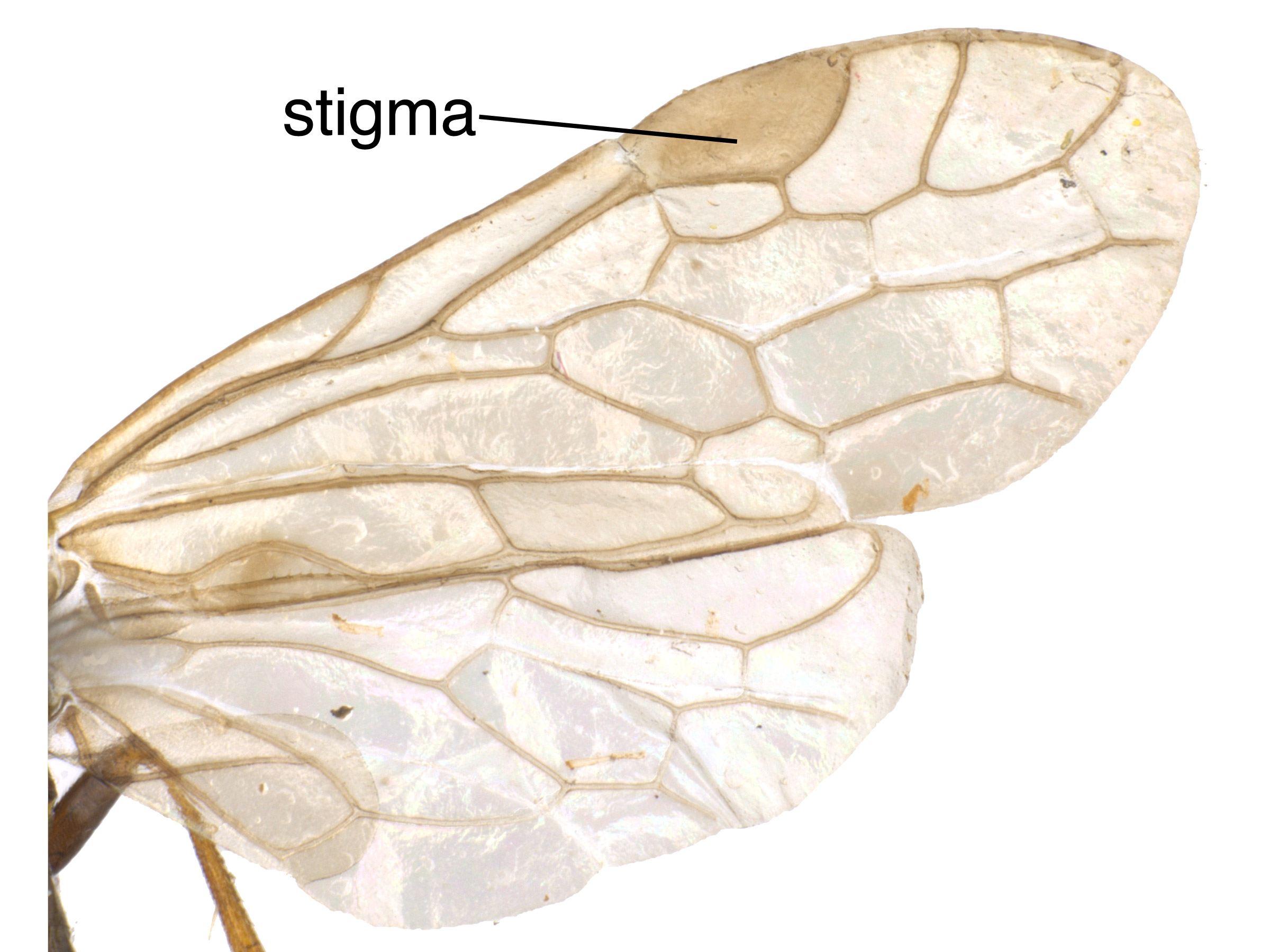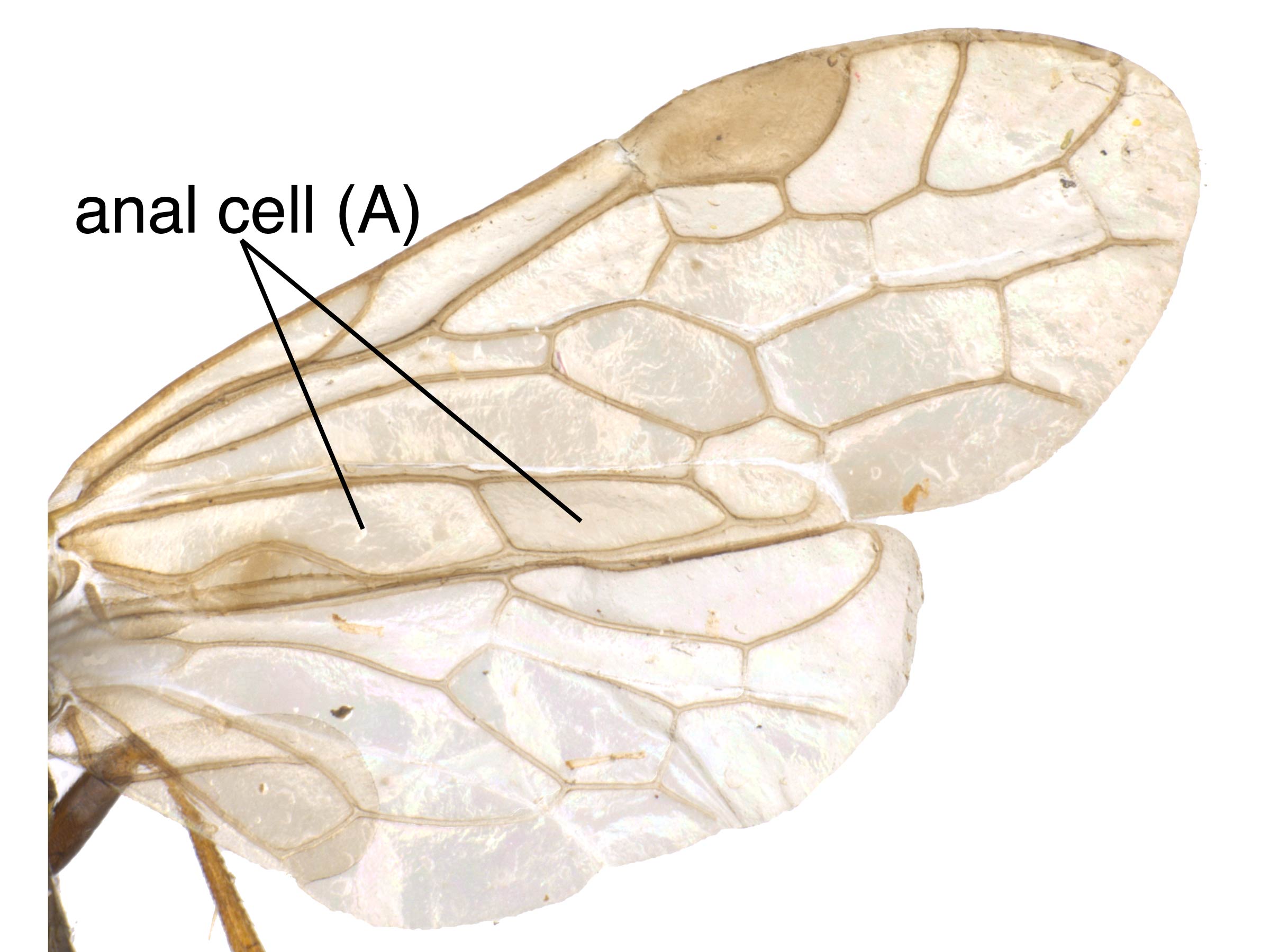Family: Tenthredinidae
Family common name: common sawflies
Subfamily: Nematinae
Tribe: Nematini
Genus: Caulocampus Rohwer, 1912
Subgenera: none
The Tenthredinidae are the most species-rich family and are found throughout the world, in all continents but Antarctica. They are known as the “common sawflies.” They can generally be recognized by a cylindrical body and long, segmented antennaeantenna:
the sensory organ emerging from the front of the head, usually between the compound eyes and above the clypeus; includes the flagellum, scape and pedicel
 . Otherwise, they come in a variety of colors, sizes, and forms (Goulet 1992Goulet 1992:
. Otherwise, they come in a variety of colors, sizes, and forms (Goulet 1992Goulet 1992:
Goulet H. 1992. The genera and subgenera of the sawflies of Canada and Alaska: Hymenoptera. Symphyta. The insects and arachnids of Canada. Part 20. Agriculture Canada Publication.).
Nematinae is the second-largest subfamily of Tenthredinidae, with over 1,250 species (Prous et al. 2014Prous et al. 2014:
Prous M, Blank SM, Goulet H, Heibo E, Liston A, Malm T, Nyman T, Schmidt S, Smith DR, Varing;rdal H, Viitasaari M, Vikberg V, and Taeger A. 2014. The genera of Nematinae (Hymenoptera, Tenthredinidae). Journal of Hymenoptera Research 40: 1-69. " target="_blank">https://doi.org/10.3897/JHR.40.7442). They are most diverse in northern Eurasia and North America; only a few species occur in the Southern Hemisphere. Nematinae sawflies have a variety of feeding habits including external leaf feeding, leaf mining, and gall forming, and feed on a variety of hosts (Smith 2003bSmith 2003b:
Smith DR. 2003b. A Synopsis of the sawflies (Hymenoptera: Symphyta) of America south of the United States: Tenthredinidae (Nematinae, Heterarthrinae, Tenthredininae). Transactions of the American Entomological Society 129 (1): 1-45.).
The Nematinae have been subject to numerous revisions in recent years. As of 2021, there are no comprehensive keys to many of the North American species of Nematinae (Prous et al. 2014Prous et al. 2014:
Prous M, Blank SM, Goulet H, Heibo E, Liston A, Malm T, Nyman T, Schmidt S, Smith DR, Varing;rdal H, Viitasaari M, Vikberg V, and Taeger A. 2014. The genera of Nematinae (Hymenoptera, Tenthredinidae). Journal of Hymenoptera Research 40: 1-69. " target="_blank">https://doi.org/10.3897/JHR.40.7442). Because of changing taxonomy and extreme variability in morphology, identifying genera and species in the Nematinae may be more challenging than in other subfamilies of Tenthredindae. For this reason, knowing the host or behaviors of a specimen can be extremely helpful for identification within this subfamily.
Caulocampus are small, about 3–5 mm in length (Prous et al. 2014Prous et al. 2014:
Prous M, Blank SM, Goulet H, Heibo E, Liston A, Malm T, Nyman T, Schmidt S, Smith DR, Varing;rdal H, Viitasaari M, Vikberg V, and Taeger A. 2014. The genera of Nematinae (Hymenoptera, Tenthredinidae). Journal of Hymenoptera Research 40: 1-69. " target="_blank">https://doi.org/10.3897/JHR.40.7442). They are mostly black or yellow-brown; both species have yellow legs (Smith 1968Smith 1968:
Smith DR. 1968. The genus Caulocampus Rohwer (Hymenoptera: Tenthredinidae). Proceedings of the Entomological Society of Washington 70 (2): 126-129.).
There are two described species worldwide, and they both occur in North America (Taeger et al. 2018Taeger et al. 2018:
Taeger A, Liston AD, Prous M, Groll EK, Gehroldt T, and Blank SM. 2018. ECatSymmdash;Electronic World Catalog of Symphyta (Insecta, Hymenoptera). Program version 5.0 (19 Dec 2018), data version 40 (23 Sep 2018). Senckenberg Deutsches Entomologisches Institut (SDEI), Muuml;ncheberg. https://sdei.de/ecatsym/ Accessed: 28 Jan 2020.).
A key to species is included in Smith 1968Smith 1968:
Smith DR. 1968. The genus Caulocampus Rohwer (Hymenoptera: Tenthredinidae). Proceedings of the Entomological Society of Washington 70 (2): 126-129..
Subfamily characters
 (Goulet 1992Goulet 1992:
(Goulet 1992Goulet 1992:Genus characters
 and pedicelpedicel:
and pedicelpedicel: long, combined length at least ¾ length of, or longer than, the first flagellomereflagellomere:
long, combined length at least ¾ length of, or longer than, the first flagellomereflagellomere: (Goulet 1992Goulet 1992:
(Goulet 1992Goulet 1992: vein 2m-cu meeting cellcell:
vein 2m-cu meeting cellcell: 2Rs above (Goulet 1992Goulet 1992:
2Rs above (Goulet 1992Goulet 1992: veins M and Rs+M relatively widely separated on veinvein:
veins M and Rs+M relatively widely separated on veinvein: R (Goulet 1992Goulet 1992:
R (Goulet 1992Goulet 1992: vein 2r-rs absent (Goulet 1992Goulet 1992:
vein 2r-rs absent (Goulet 1992Goulet 1992: vein 2A+3A meeting 1A; basalbasal:
vein 2A+3A meeting 1A; basalbasal: present (Prous et al. 2014Prous et al. 2014:
present (Prous et al. 2014Prous et al. 2014: cellcell:
cellcell: A somewhat quadratequadrate:
A somewhat quadratequadrate: (Prous et al. 2014Prous et al. 2014:
(Prous et al. 2014Prous et al. 2014: wide medially; membranous area posterior to tergitetergite:
wide medially; membranous area posterior to tergitetergite: 1 small (Goulet 1992Goulet 1992:
1 small (Goulet 1992Goulet 1992: inner tooth long and thin (Goulet 1992Goulet 1992:
inner tooth long and thin (Goulet 1992Goulet 1992:Caulocampus may be confused with other genera in the subfamily Nematinae — particularly those with shorter antennaeantenna:
the sensory organ emerging from the front of the head, usually between the compound eyes and above the clypeus; includes the flagellum, scape and pedicel
 such as Adelomos or Hoplocampa — but can be distinguished by the space between fore wingfore wing:
such as Adelomos or Hoplocampa — but can be distinguished by the space between fore wingfore wing:
the anterior wing of each pair of wings; usually the largest wing of the pair
 veins M and Rs+M on veinvein:
veins M and Rs+M on veinvein:
a tube-like, often darkened, structure on the wings
 R, the absence of veinvein:
R, the absence of veinvein:
a tube-like, often darkened, structure on the wings
 2r-rs, the length of the scapescape:
2r-rs, the length of the scapescape:
the first antennal segment
 and pedicelpedicel:
and pedicelpedicel:
the second antennal segment, between the scape and flagellum
 , and the location of fore wingfore wing:
, and the location of fore wingfore wing:
the anterior wing of each pair of wings; usually the largest wing of the pair
 vein 2m-cu (Goulet 1992Goulet 1992:
vein 2m-cu (Goulet 1992Goulet 1992:
Goulet H. 1992. The genera and subgenera of the sawflies of Canada and Alaska: Hymenoptera. Symphyta. The insects and arachnids of Canada. Part 20. Agriculture Canada Publication.).
none
Caulocampus acericaulis feeds on Acer (maple) (Goulet 1992Goulet 1992:
Goulet H. 1992. The genera and subgenera of the sawflies of Canada and Alaska: Hymenoptera. Symphyta. The insects and arachnids of Canada. Part 20. Agriculture Canada Publication.).
Females of C. acericaulis, the “maple petiolepetiole:
stalk or stem; used to describe basal vein stalk in wing OR basal stalk of a leaf.
borer,” oviposit into the petioles of maple leaves. The larvaelarva:
the immature stage of holometabolous insects
 feed inside the petiolepetiole:
feed inside the petiolepetiole:
stalk or stem; used to describe basal vein stalk in wing OR basal stalk of a leaf.
, hollowing out the vascular tissue. This feeding behavior causes the leaves to change color and prematurely fall off the tree, leaving behind a section of petiolepetiole:
stalk or stem; used to describe basal vein stalk in wing OR basal stalk of a leaf.
with the larvalarva:
the immature stage of holometabolous insects
 still inside. At maturity, the larvaelarva:
still inside. At maturity, the larvaelarva:
the immature stage of holometabolous insects
 fall to the ground and burrow into the soil to overwinter and subsequently pupate. The species is univoltineunivoltine:
fall to the ground and burrow into the soil to overwinter and subsequently pupate. The species is univoltineunivoltine:
describing an insect with a life cycle of one generation per year
(Smith 1968Smith 1968:
Smith DR. 1968. The genus Caulocampus Rohwer (Hymenoptera: Tenthredinidae). Proceedings of the Entomological Society of Washington 70 (2): 126-129., Hale 2011Hale 2011:
Hale FA. 2011. Insects: maple petiole borer. University of Tennessee Extension Publications SP290-M.).
World: The genus is known only from North America (Taeger et al. 2010Taeger et al. 2010:
Taeger A, Blank SM, and Liston AD. 2010. World Catalog of Symphyta (Hymenoptera). Zootaxa 2580: 1-1064.).
North America: Caulocampus occurs in the northeastern United States and southeastern Canada (Smith 1968Smith 1968:
Smith DR. 1968. The genus Caulocampus Rohwer (Hymenoptera: Tenthredinidae). Proceedings of the Entomological Society of Washington 70 (2): 126-129.).
Map data from: GBIF.org (29 October 2019) GBIF Occurrence Download Caulocampus
Details about data used for maps can be found here.